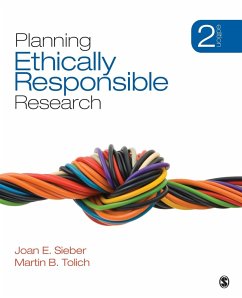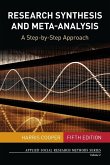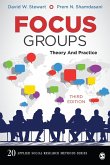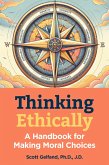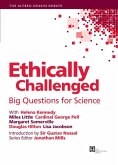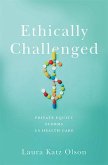- Broschiertes Buch
- Merkliste
- Auf die Merkliste
- Bewerten Bewerten
- Teilen
- Produkt teilen
- Produkterinnerung
- Produkterinnerung
This book is an invaluable guide to help researchers and graduate students understand ethical concerns within real-life research situations.
Andere Kunden interessierten sich auch für
![Research Synthesis and Meta-Analysis Research Synthesis and Meta-Analysis]() Harris CooperResearch Synthesis and Meta-Analysis95,99 €
Harris CooperResearch Synthesis and Meta-Analysis95,99 €![Focus Groups Focus Groups]() David W. StewartFocus Groups69,99 €
David W. StewartFocus Groups69,99 €![Practical Meta-Analysis Practical Meta-Analysis]() Mark W. LipseyPractical Meta-Analysis176,99 €
Mark W. LipseyPractical Meta-Analysis176,99 €![Working Ethically in Child Protection Working Ethically in Child Protection]() Bob LonneWorking Ethically in Child Protection50,99 €
Bob LonneWorking Ethically in Child Protection50,99 €![Thinking Ethically Thinking Ethically]() Scott GelfandThinking Ethically17,99 €
Scott GelfandThinking Ethically17,99 €![Ethically Challenged Ethically Challenged]() Jonathan, Mills,Ethically Challenged12,99 €
Jonathan, Mills,Ethically Challenged12,99 €![Ethically Challenged Ethically Challenged]() Laura Katz OlsonEthically Challenged42,99 €
Laura Katz OlsonEthically Challenged42,99 €-
-
-
This book is an invaluable guide to help researchers and graduate students understand ethical concerns within real-life research situations.
Produktdetails
- Produktdetails
- Applied Social Research Methods
- Verlag: SAGE Publications Inc
- Artikelnr. des Verlages: B02594P
- 2 Revised edition
- Seitenzahl: 264
- Erscheinungstermin: 26. Dezember 2012
- Englisch
- Abmessung: 235mm x 191mm x 14mm
- Gewicht: 444g
- ISBN-13: 9781452202594
- ISBN-10: 1452202591
- Artikelnr.: 33986417
- Herstellerkennzeichnung
- Libri GmbH
- Europaallee 1
- 36244 Bad Hersfeld
- gpsr@libri.de
- Applied Social Research Methods
- Verlag: SAGE Publications Inc
- Artikelnr. des Verlages: B02594P
- 2 Revised edition
- Seitenzahl: 264
- Erscheinungstermin: 26. Dezember 2012
- Englisch
- Abmessung: 235mm x 191mm x 14mm
- Gewicht: 444g
- ISBN-13: 9781452202594
- ISBN-10: 1452202591
- Artikelnr.: 33986417
- Herstellerkennzeichnung
- Libri GmbH
- Europaallee 1
- 36244 Bad Hersfeld
- gpsr@libri.de
Joan E. Sieber, a psychologist and Professor Emerita, California State University, East Bay, has specialized in empirical research on questions of scientific ethics, culturally sensitive methods of research and intervention, data sharing methodology, and scholarship on ethical problem solving. In 2001-2002, she was Acting Director of the National Science Foundation program Societal Dimensions of Engineering, Science and Technology. She is the author of eight books and numerous other publications including software and encyclopedia entries on ethical problem solving in social and behavioral research.
Chapter 1. Introduction: Research Governance and Research Ethics
Chapter 2. Why We Need Ethics: Assessing Vulnerability, Risk and Benefit
Chapter 3. The Relevance of Ethical Theory to IRB
Chapter 4. A Retrospective IRB Review: Rehabilitating Milgram, Zimbardo and
Humphreys
Chapter 5. Journalist Ethics Does Not Equal Social Scientists Ethics
Chapter 6. Community-Engaged Research and Ethnography: Extreme Misfits with
the Medical Model
Chapter 7. Communicating Informed Consent and Process Consent
Chapter 8. Degrees of non-Disclosure
Chapter 9. Strategies for Assuring Confidentiality
Chapter 10. The Ethics for the Invisible, Powerless and Vulnerable Research
Assistant
Chapter 11. Why IRBs Have an Important Place: The Autoethnographic
Experiment
Chapter 12. Evidence-Based Ethical Problem Solving: A Research Agenda
Chapter 13. Making Ethics Review a Learning Institution: Ten Simple
Suggestions
Chapter 2. Why We Need Ethics: Assessing Vulnerability, Risk and Benefit
Chapter 3. The Relevance of Ethical Theory to IRB
Chapter 4. A Retrospective IRB Review: Rehabilitating Milgram, Zimbardo and
Humphreys
Chapter 5. Journalist Ethics Does Not Equal Social Scientists Ethics
Chapter 6. Community-Engaged Research and Ethnography: Extreme Misfits with
the Medical Model
Chapter 7. Communicating Informed Consent and Process Consent
Chapter 8. Degrees of non-Disclosure
Chapter 9. Strategies for Assuring Confidentiality
Chapter 10. The Ethics for the Invisible, Powerless and Vulnerable Research
Assistant
Chapter 11. Why IRBs Have an Important Place: The Autoethnographic
Experiment
Chapter 12. Evidence-Based Ethical Problem Solving: A Research Agenda
Chapter 13. Making Ethics Review a Learning Institution: Ten Simple
Suggestions
Chapter 1. Introduction: Research Governance and Research Ethics
Chapter 2. Why We Need Ethics: Assessing Vulnerability, Risk and Benefit
Chapter 3. The Relevance of Ethical Theory to IRB
Chapter 4. A Retrospective IRB Review: Rehabilitating Milgram, Zimbardo and
Humphreys
Chapter 5. Journalist Ethics Does Not Equal Social Scientists Ethics
Chapter 6. Community-Engaged Research and Ethnography: Extreme Misfits with
the Medical Model
Chapter 7. Communicating Informed Consent and Process Consent
Chapter 8. Degrees of non-Disclosure
Chapter 9. Strategies for Assuring Confidentiality
Chapter 10. The Ethics for the Invisible, Powerless and Vulnerable Research
Assistant
Chapter 11. Why IRBs Have an Important Place: The Autoethnographic
Experiment
Chapter 12. Evidence-Based Ethical Problem Solving: A Research Agenda
Chapter 13. Making Ethics Review a Learning Institution: Ten Simple
Suggestions
Chapter 2. Why We Need Ethics: Assessing Vulnerability, Risk and Benefit
Chapter 3. The Relevance of Ethical Theory to IRB
Chapter 4. A Retrospective IRB Review: Rehabilitating Milgram, Zimbardo and
Humphreys
Chapter 5. Journalist Ethics Does Not Equal Social Scientists Ethics
Chapter 6. Community-Engaged Research and Ethnography: Extreme Misfits with
the Medical Model
Chapter 7. Communicating Informed Consent and Process Consent
Chapter 8. Degrees of non-Disclosure
Chapter 9. Strategies for Assuring Confidentiality
Chapter 10. The Ethics for the Invisible, Powerless and Vulnerable Research
Assistant
Chapter 11. Why IRBs Have an Important Place: The Autoethnographic
Experiment
Chapter 12. Evidence-Based Ethical Problem Solving: A Research Agenda
Chapter 13. Making Ethics Review a Learning Institution: Ten Simple
Suggestions

